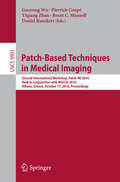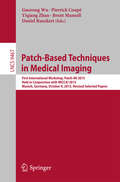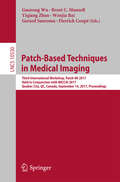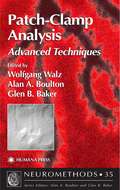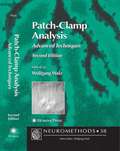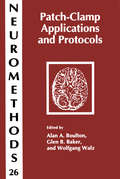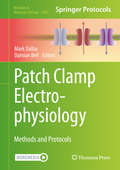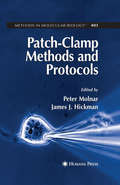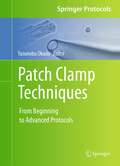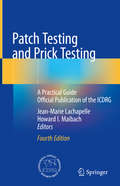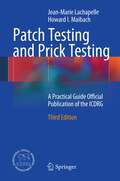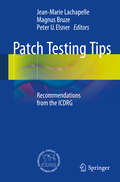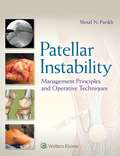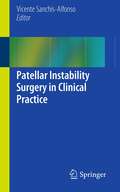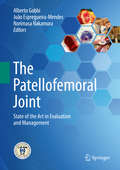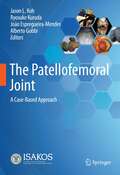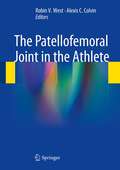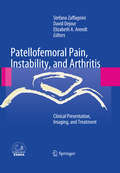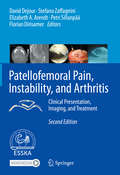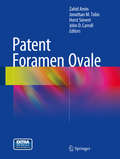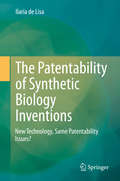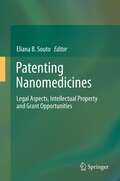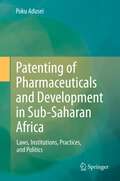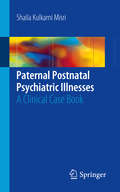- Table View
- List View
Patch-Based Techniques in Medical Imaging
by Guorong Wu Pierrick Coupé Yiqiang Zhan Brent C. Munsell Daniel RueckertThis book constitutes the refereed proceedings of the Second International Workshop on Patch-Based Techniques in Medical Images, Patch-MI 2016, which was held in conjunction with MICCAI 2016, in Athens, Greece, in October 2016. The 17 regular papers presented in this volume were carefully reviewed and selected from 25 submissions. The main aim of the Patch-MI 2016 workshop is to promote methodological advances within the medical imaging field, with various applications in image segmentation, image denoising, image super-resolution, computer-aided diagnosis, image registration, abnormality detection, and image synthesis.
Patch-Based Techniques in Medical Imaging
by Guorong Wu Pierrick Coupé Yiqiang Zhan Brent Munsell Daniel RueckertThis book constitutes the thoroughly refereedpost-workshop proceedings of the First International Workshop on Patch-based Techniquesin Medical Images, Patch-MI 2015, which was held in conjunction with MICCAI2015, in Munich, Germany, in October 2015. The 25 full papers presented in this volume werecarefully reviewed and selected from 35 submissions. The topics covered are suchas image segmentation of anatomical structures or lesions; image enhancement;computer-aided prognostic and diagnostic; multi-modality fusion; mono and multimodal image synthesis; image retrieval; dynamic, functional physiologic andanatomic imaging; super-pixel/voxel in medical image analysis; sparsedictionary learning and sparse coding; analysis of 2D, 2D+t, 3D, 3D+t, 4D, and4D+t data.
Patch-Based Techniques in Medical Imaging
by Guorong Wu Brent C. Munsell Yiqiang Zhan Wenjia Bai Gerard Sanroma Pierrick CoupéThis book constitutes the refereed proceedings of the Second International Workshop on Patch-Based Techniques in Medical Images, Patch-MI 2016, which was held in conjunction with MICCAI 2016, in Athens, Greece, in October 2016. The 17 regular papers presented in this volume were carefully reviewed and selected from 25 submissions. The main aim of the Patch-MI 2016 workshop is to promote methodological advances within the medical imaging field, with various applications in image segmentation, image denoising, image super-resolution, computer-aided diagnosis, image registration, abnormality detection, and image synthesis.
Patch-Clamp Analysis
by Alan A. Boulton Wolfgang Walz Glen B. BakerPatch-Clamp Analysis: Advanced Techniques describes in reproducible detail all applications that involve patch pipet. Beginning with updated basic patch-clamp techniques, the book presents the newest developments, ranging from fast external solution switching and the switching of the pipet solution during recording, to the loose patch, the perforated patch, and the patch cram detection technique. The advanced techniques covered combine molecular biology and imaging to produce the patch pipet with RT-PCR and fluorometric techniques.
Patch-Clamp Analysis
by Wolfgang WalzContinuing the research of the best-selling first edition, this second edition collects three more years of research in the ever-expanding study of the cell membrane. It covers the latest developments in the "traditional" patch techniques. This authoritative second edition updates the standard techniques while introducing three brand new, cutting-edge technical advances in the field. Thorough and timely, this edition is an invaluable resource.
Patch-Clamp Applications and Protocols
by Alan A. Boulton Wolfgang Walz Glen B. BakerPatch-Clamp Applications and Protocols presents the broadest coverage of techniques for measuring and recording directly activity within a cell. The first part of the book offers modern developments associated with the technology of path-clamp electrodes, of cell-free ion-channel recording, and of the whole-cell patch clamp technique. Chapters on such recent offspring of the technique as the concentration clamp technique, the pressure clap method, and the perfusion of patch clamp electrodes are contributed by authors intimately involved with their development. Also covered is the loose patch-clamp technique, single-channel recording, the perforated patch-clamp technique, molecular biological aspects of the technique, and the use of the technique in brain slices. Every scientist working with path-clamp methods will find this protocols manual invaluable to their continued use and development of this powerful technique.
Patch Clamp Electrophysiology: Methods and Protocols (Methods in Molecular Biology #2188)
by Mark Dallas Damian BellThis volume describes a range of standard and novel methodological approaches used to probe ion channel function across different modalities. Chapters guide readers through methods and protocols from an introduction to the decades old patch clamp method for the ion channel neophyte to more complex, recent protocol advances, such as optogenetics. Written in the highly successful Methods in Molecular Biology series format, chapters include introductions to their respective topics, application details for both the expert and non-expert reader, and tips on troubleshooting and avoiding known pitfalls. Authoritative and practical, Patch Clamp Electrophysiology: Methods and Protocols aims to be a reference guide for current and future ion channel physiologists.
Patch-Clamp Methods and Protocols
by James J. Hickman Peter MolnarPatch Clamp Methods and Protocols surveys the typical patch clamp applications and advises scientists on identifying problems and selecting the best technique in each instance. The experiments described aid the researcher in pursuing new areas of electrophysiology and using the patch clamp technique effectively. The volume includes an extensive theoretical treatise concerning single channel kinetic analysis.
Patch Clamp Techniques
by Yasunobu OkadaChannels and transporters are multi-functional proteins that mediate substrate transport and signal transmission and simultaneously act as regulators for other proteins and biosensors for environmental materials. Patch clamping is an epoch-making technique that allows researchers to perform real-time measurements of electrogenic channel/transporter functions at the single/multiple molecular level. This book describes not only the conventional patch clamp techniques but also their newly developed variations or applications, such as perforated patch, slice patch, blind patch, in vivo patch, imaging patch, smart patch, and automated patch clamping. These patch clamp techniques are now essential and are extensively used across the life sciences and in related industries. With plain and practical descriptions of patch clamping and how to carry it out, especially for beginners, the book also shows how widely and exquisitely the patch clamp techniques can be applied by expert electrophysiologists. This work serves as a useful guide for young researchers and students in training and laboratory courses as well as for senior researchers who wish to extend their repertoire of techniques.
Patch Testing and Prick Testing: A Practical Guide Official Publication of the ICDRG
by Jean-Marie Lachapelle Howard I. MaibachThe fourth edition of this important book, which includes additional color illustrations, has been extensively revised, updated, and expanded to reflect the most recent developments. These include advances in patch testing methodology, in particular the new chambers that are appearing on the market, revision of the baseline series of patch tests to reflect the latest evidence-based work, and additional testing procedures. Other additions include sections on key allergens and concentrations, with the result is a superb guide to the current management of positive and negative patch test and prick test reactions that will be invaluable for all practicing dermatologists, from the beginner to the well-trained expert.The fourth edition continues the tradition of partnering with the ICDRG (International Contact Dermatitis Research Group). The ICDRG was formed in 1966 to promote the understanding of contact dermatitis. It has had major roles in the standardization of patch testing and the facilitation of regular scientific meetings, for over forty years and thirty five years respectively. It has also been involved in the authorship of a number of publications on contact dermatitis. Both Drs. Maibach and Lachapelle are members and the ICDRG is now comprised of representatives from all over the world, and currently includes members from Belgium, Sweden, Denmark, the United Kingdom, USA, Germany, Singapore, Korea, India, Japan, Canada, Uruguay and Australia.From the reviews of the previous editions:"The aim is to balance brevity and clarity with sufficient details for beginners in the field of diagnostic patch and prick testing. … the book also will be of use to dermatology residents or anyone wishing to gain better knowledge of contact dermatitis. … There are many high-quality photographs and useful algorithms and tables. … It is clearly and concisely written and will serve as an indispensable guide for any dermatologist interested in contact dermatitis." (Renata H. Mullen, Doody’s Review Service, August, 2009)
Patch Testing and Prick Testing
by Howard I. Maibach Jean-Marie LachapelleKnowledge in the field of allergic contact dermatitis continues to expand rapidly owing to progress in the chemical, immunological, and clinical fields, including improved techniques of patch testing and prick testing. The third edition of this important book, which includes additional color illustrations, has been extensively revised, updated, and expanded to reflect the most recent developments. These include advances in patch testing methodology, in particular the new chambers that are appearing on the market, revision of the baseline series of patch tests to reflect the latest evidence-based work, and additional testing procedures. The result is a superb guide to the current management of positive and negative patch test and prick test reactions that will be invaluable for all practicing dermatologists, from the beginner to the well-trained expert.
Patch Testing Tips
by Jean-Marie Lachapelle Magnus Bruze Peter U. ElsnerThis book is a compendium of tips on many different aspects of patch testing based on the recommendations of the International Contact Dermatitis Research Group (ICDRG), which is the reference group for all dermato-allergologists. It is intended to complement the book Patch Testing and Prick Testing: A Practical Guide by J. -M. Lachapelle and H. Maibach, which is an official publication of the ICDRG now in its third edition. Among the wide variety of topics covered are pitfalls, legal aspects, patch testing with ultrasonic bath extracts, the role of patch testing in occupational contact dermatitis and atopic dermatitis, semi-open tests, the implications of a negative test, patch testing validity, selection of extra allergens and patch testing in the tropics. Many illustrations are included and all information is completely up-to-date. This book will be of value to all practicing dermatologists.
Patellar Instability: Management Principles and Operative Techniques
by Shital N. ParikhWritten by experts in the field, Patellar Instability and Dislocation: Classification and Operative Techniques is a comprehensive, authoritative review of the procedures used to address this challenging condition. Includes step-by-step procedures, both in print and on video, to guide you through today's most effective approaches to stabilization and reconstruction, trochleoplasty, limb realignment osteotomy, and much more.
Patellar Instability Surgery in Clinical Practice
by Vicente Sanchis-AlfonsoAmong all the extensor mechanism pathologies, lateral patellar instability is of great interest not only for the knee specialist, but also for the general orthopedic surgeon and trainee. The procedure that is most frequently performed to treat lateral patellar instability is the medial patellofemoral ligament (MPFL) reconstruction. The reason for this great interest in this procedure is obvious. Medial patellofemoral ligament reconstruction is the most frequently performed procedure in the extensor mechanism. It also is the most predictable and has the best clinical results of all the procedures in the extensor mechanism. In this handbook we analyse the different reconstruction techniques, step by step, for the MPFL reconstruction, as well as other techniques less frequently used in the patient with lateral patellofemoral instability. We also analyse the treatment of medial patellofemoral instability. It is a very practical book, aimed at the general orthopedic surgeon and also the ones specialized in the knee.
The Patellofemoral Joint
by Alberto Gobbi João Espregueira-Mendes Norimasa NakamuraThis book is a comprehensive and thorough compilation of work from across the world that documents the state of the art in assessment and management of the patellofemoral joint. While a wide range of surgical techniques for different pathologies are described, attention is also devoted to conservative treatment and approaches involving mesenchymal stem cells, autologous chondrocyte implantation, platelet-rich plasma, and pulsed electromagnetic fields. Anatomy, clinical examination, and methods of evaluation are discussed, and individual chapters address important miscellaneous topics, including rehabilitation, complications of surgery, injuries in specific patient populations, and scoring systems. Though patellofemoral joint pathology is a frequent clinical problem, its management remains challenging for the orthopaedic surgeon. The editors believe that this book, published in cooperation with ISAKOS, will assist in improving understanding, diagnosis, and treatment for future patients.
The Patellofemoral Joint: A Case-Based Approach
by Jason L. Koh Ryosuke Kuroda João Espregueira-Mendes Alberto GobbiThis practical case-based book assists clinicians in the evaluation and treatment of patellofemoral patients by reviewing critical elements for assessment and presenting clinical scenarios in which different experts provide their recommendations for treatment.Subdivided in 6 parts it explores the joint’s anatomy and mechanics, as well as case-based evaluation and treatment of patellofemoral instability, arthritis and chondrosis, traumatic injuries and degenerative tendinopathies. Moreover, the closing part offers an overview of the latest advances and future developments. Written in collaboration with ISAKOS, this book offers a valuable guide for orthopedists and sports medicine treating common and complex injuries of this joint.
The Patellofemoral Joint in the Athlete
by Robin V. West Alexis C. ColvinPatellofemoral disorders are extremely prevalent in athletes and can lead to chronic pain, instability, weakness, and inconsistent or poor athletic performance. These disorders can be difficult to diagnose. Treatment options can vary depending upon several factors, including the sport and the time during the sports season when the symptoms occur. Treatment also varies depending on the age of the patient and their competition level. The Patellofemoral Joint in the Athlete provides an extensive review of the physical examination, radiographic evaluation, differential diagnoses, and treatment options of common patellofemoral disorders, including patellar chondrosis, pain and instability. The contributors are nationally recognized experts in the patellofemoral joint that treat athletes of all ages and abilities. Appropriate for orthopedic surgeons, sports medicine physicians, rehabilitation physicians and physical therapists, this book is a comprehensive guide to the unique and sport-specific concerns of athletes of all ages and abilities with regard to the patellofemoral joint.
Patellofemoral Pain, Instability, and Arthritis
by Elizabeth A. Arendt Stefano Zaffagnini David DejourDespite numerous studies, a lack of consensus still exists over many aspects of patellofemoral pain, instability, and arthritis. This book adopts an evidence-based approach to assess each of these topics in depth. The book reviews general features of clinical examination and global evaluation techniques including the use of different imaging methods, e.g. x-rays, CT, MRI, stress x-rays, and bone scan. Various conservative and surgical treatment approaches for each of the three presentations - pain, instability, and arthritis - are then explained and assessed. Postoperative management and options in the event of failed surgery are also evaluated. Throughout, careful attention is paid to the literature in an attempt to establish the level of evidence for the efficacy of each imaging and treatment method. It is hoped that this book will serve as an informative guide for the practitioner when confronted with disorders of the patellofemoral joint.
Patellofemoral Pain, Instability, and Arthritis: Clinical Presentation, Imaging, and Treatment
by David Dejour Stefano Zaffagnini Elizabeth A. Arendt Petri Sillanpää Florian DirisamerThis excellently illustrated book adopts an evidence-based approach to evaluate the efficacy of different techniques for the imaging and treatment of patellofemoral pain, instability, and arthritis. The aim is to equip practitioners with an informative guide that will help them to manage disorders of the patellofemoral joint by casting light on the many issues on which a consensus has been lacking. The opening chapters supply essential background information and explain the role of various imaging modalities, including radiography, CT, MRI, and bone scan. The various conservative and surgical treatment approaches for each of the three presentations – pain, instability, and arthritis – are then described and assessed in depth, with precise guidance on indications and technique. Postoperative management and options in the event of failed surgery are also evaluated. Throughout, careful attention is paid to the literature in an attempt to establish the level of evidence for each imaging and treatment method. The new edition has been thoroughly updated, with inclusion of additional chapters, in order to present the latest knowledge on biomechanics, diagnosis, surgical techniques, and rehabilitation.
Patent Foramen Ovale
by Zahid Amin Jonathan M. Tobis Horst Sievert John D. CarrollThis book is the ultimate reference on patent foramen ovale (PFO), a defect in the septum of the heart estimated to be present in more than twenty percent of the adult population and a proven cause of systemic embolism. All chapters have been written by internationally recognized experts in the field and cover PFO genetics and anatomy in addition to the effect PFO can have on various different organs and its supposed involvement in several conditions and clinical syndromes such as migraine, diving incidence, platynea orthodeoxia, economy class syndrome, sleep apnea and persistent desaturations in mild right ventricular dysfunction. As PFO anatomy varies significantly between individuals, chapters have also been included on the diagnostic tools, methods and techniques for appropriate assessment, detection and characterization of PFO. Furthermore, the multitude of available closure devices and techniques for PFO closure are discussed together with current and ongoing trial data. The book concludes with guidance and instruction on establishing a successful PFO program. Patent Foramen Ovale will be an essential text for the whole adult and pediatric interventional community, general cardiologists, internists, primary care physicians, neurologists and device companies in addition to medical students, graduate students and fellows in training.
The Patentability of Synthetic Biology Inventions: New Technology, Same Patentability Issues?
by Ilaria de LisaThis book addresses Synthetic Biology (SynBio), a new and promising biotechnology that has attracted much interest from both a scientific and a policy perspective. Yet, questions concerning the patentability of SynBio inventions have not been examined in detail so far; as a result, it remains unclear whether these inventions are patentable on the basis of current norms and case law. The book addresses this question, focusing especially on the subject matter’s eligibility and moral criteria. It provides an overview of the legislation and decisions applicable to SynBio patents and examines this new technology in view of the ongoing debate over the patentability of biotechnologies in general. The legal analysis is complemented by the practical examination of several patent applications submitted to the European and US patent offices (EPO and USPTO), and by an assessment of the patent issues that are likely to be raised by future SynBio developments.
Patenting Nanomedicines
by Eliana B. Souto"Patenting Nanomedicines: Legal Aspects, Intellectual Property and Grant Opportunities" focusses on the fundamental aspects of Patenting Nanomedicines applied in different "Drug Delivery and Targeting Systems". The promoters of new findings in this field of research are numerous and spread worldwide; therefore, managing intellectual property portfolios, and the acquisition and exploitation of new knowledge face several contingency factors. Today, the scientific community is discussing issues of economic outcomes in the field of Nanomedicines. Major concerns include questions as to whether the research groups, academics, industry and other stakeholders should work in unison or independently, if innovation or adaptation of new technology should be prioritized, public versus private research funding, and safeguarding versus sharing knowledge. However, despite its increasing importance for humankind, it is a matter of concern as to whether technological development can really be stimulated by patent protection. An intellectual property strategy should aim to develop a qualitative patent portfolio for continuous learning. This book addresses questions of ethics, socio-political policies and regulatory aspects of novel Nanomedicine-based products which are currently under development for the diagnosis and treatment of different types of diseases. It is divided in two parts - Part I is composed of the first 3 chapters, which focus on the "fundamentals" of legal aspects, emerging threats, advantages and disadvantages of patenting Nanomedicines, whereas Part II collects 12 chapters discussing different types of Nanomedicine-based products, their potential marketing aspects and patent protection. Whenever applied, each chapter offers a list of patents, based on a specific application in drug delivery and targeting. An outstanding team of 53 authors have contributed to this book, which will be of interest to professionals from the field of patent examiners, academics, researchers and scientists, students and other practitioners.
Patenting of Pharmaceuticals and Development in Sub-Saharan Africa
by Poku AduseiThis book critically investigates the patent protection of medication in light of the threats posed by HIV/AIDS, malaria and tuberculosis epidemics to the citizens of countries in Sub-Saharan Africa (hereinafter "SSA" or "Africa"). The book outlines the systemic problems associated with the prevailing globalized patent regime and the regime's inability to promote access to life-saving medication at affordable prices in SSA. It argues that for pharmaceutical patents to retain their relevance in SSA countries, human development concepts must be integrated into global patent law- and policy-making. An integrative approach implies developing additional public health and human development exceptions/limitations to the exercise of patent rights with the goal of scaling up access to medication that can treat epidemics in SSA. By drawing on multiple perspectives of laws, institutions, practices, and politics, the book suggests that SSA countries adopt an evidence-based approach to implementing global patent standards in domestic jurisdictions. This evidence-based approach would include mechanisms like local need assessments and the use of empirical data to shape domestic patent law-making endeavors. The approach also implies revising patent rules and policies with a pro-poor and pro-health emphasis, so that medication will be more affordable and accessible to the citizens of SSA countries. It also suggests considering the opinions of individuals and pro-access institutions in enacting crucial pieces of health-related statutes in SSA countries. The approach in this book is sensitive to the public health needs of the citizens affected by epidemics and to the imperative of building local manufacturing facilities for pharmaceutical research and development in SSA.
Paternal Influences on Human Reproductive Success
by Douglas T. CarrellHistorically, sperm have been seen as simply a mechanism of transferring a haploid set of chromosomes to the oocyte. However, data from assisted reproduction therapies (ART) have demonstrated that in many couples the sperm appears to be responsible for abnormal embryogenesis. Recent advances in genetic and epigenetic techniques have identified key mechanisms by which the sperm, and the DNA carried by the sperm, can affect early embryonic development. Paternal Influences on Human Reproductive Success examines the genetic and epigenetic influences on embryogenesis, as well as practical clinical factors related to the male contribution to reproductive success. It also provides 'cutting edge' data and analysis of recent evaluations of the role of advanced paternal age, environmental influences and lifestyle factors on male reproductive fitness, making this an invaluable text for physicians treating patients for infertility, recurrent pregnancy loss, and developmental anomalies, as well as basic scientists studying embryogenesis and spermatogenesis.
Paternal Postnatal Psychiatric Illnesses: A Clinical Case Book
by Shaila Kulkarni MisriThis book is the first to present the current research showing that like mothers, some fathers struggle with postpartum psychiatric illnesses and have unique needs of their own. Each chapter opens with a case vignette that describes different psychopathologies in the father and demonstrates the unique struggles presented by each situation. The cases highlight social, emotional and cultural upheaval that fathers may experience during the postpartum period. Sections in each chapter include manifestations of their illness, DSM-5 diagnoses, case discussion, treatment interventions and recommendations for health care professionals. This volume also puts paternal postpartum depression into conversation with other psychiatric comorbidities, including various personality disorders, anxiety disorders, and addictions. The text also addresses the various stigmas associated with these unique cases and offers clinical pearls on how to treat these families while giving consideration to the needs of the family.Written by renown experts in postpartum health, Paternal Postnatal Psychiatric Illnesses is an excellent resource for psychiatrists, psychologists, family therapists, general practitioners, obstetricians, social workers, and all clinicians working with postpartum families.
